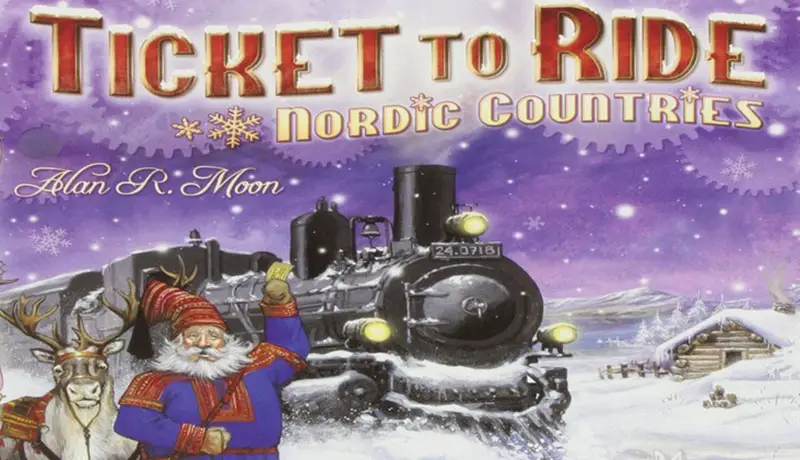
Components
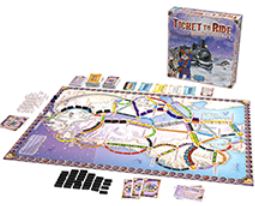
- Board Map of Nordic Countries
- 120 Colored Train Cars
- 110 Train Car cards
- 46 Destination Tickets
- 1 Globetrotter Bonus card
- 3 Wooden Scoring Markers
- 1 Rules booklet
Setup
Place the board map in the center of the table. Each player takes a set of 40 Colored Train Cars along with its matching Scoring Marker. Each player places his Scoring Marker on the starting location next to the 100 number on the Scoring Track running along the map's border.
Throughout the game, each time a player scores points, he will advance his marker accordingly. Shuffle the Train Car cards and deal a starting hand of 4 cards to each player. Place the remaining deck of Train Car cards near the board and turn the top five cards from the deck face-up.
Place the Globetrotter Bonus card face up next to the board.
Shuffle the Destination Ticket cards and deal 5 cards to each player. The Destination Ticket deck is then placed next to the board. Each player looks at their Destination Tickets and decides which ones they wish to keep.
A player must keep at least two, but may keep all five if he chooses. Any returned cards are removed from the game and put back in the box. Players keep their Destination Tickets secret until the end of the game.
You are now ready to begin.
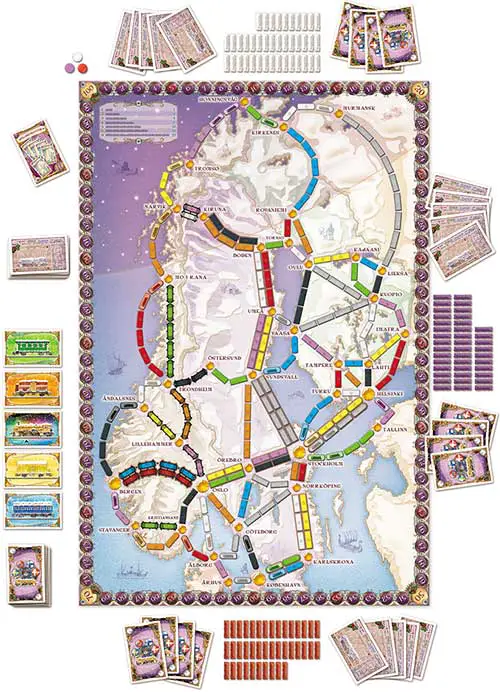
Object of the Game
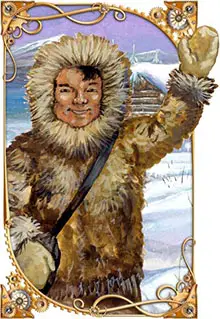
The object of the game is to score the highest number of total points. Points can be scored by:
Claiming a Route between two adjacent cities on the map;
Successfully completing a Continuous Path of routes between two cities listed on your Destination Ticket(s);
Completing the most Destination Tickets.
Points are deducted if you do not successfully complete the route on any given Destination Tickets you kept.
Game Play
The player who is the most experienced traveler goes first. Play then proceeds clockwise around the table, each player taking one turn at a time until the game ends. On his turn, a player must perform one (and only one) of the following three actions:
Draw Train Car Cards
The player may draw 2 Train Car cards. He may take any one of the face-up cards or he may draw the top card from the deck (this is a blind draw).
If he draws a face up card, he immediately turns a replacement card face-up from the deck. He then draws his second card, either from the face up cards or from the top of the deck.
Note: Unlike most Ticket To Ride games there is no restriction on the number of Locomotive cards you may draw per turn.
Claim a Route
The player may claim a route on the board by playing a set of Train Car cards that match the color and length of the route and then placing one of his colored trains on each space of that route.
He then records his score by moving his Scoring Marker the appropriate number of spaces (see Route Scoring Table) along the Scoring Track on the board.
Draw Destination Tickets
The player may draw 3 Destination Tickets from the top of the deck. He must keep at least one of them, but he may keep two or all three if he chooses.
Any returned cards are removed from the game and put back in the box, not to return to the game.
Train Car Cards
There are 8 types of regular Train Car cards, plus Locomotive cards. The colors of each type of Train Car card match various routes between cities on the board - Purple, Blue, Orange, White, Green, Yellow, Black, and Red.
Locomotives are multi-colored and act as a wild card that can be part of a set of cards only when claiming Tunnel or Ferry routes (see Tunnels and Ferries below).
Locomotive cards can complement or replace the colored cards required to claim a Tunnel or Ferry route, but they can never be used to help claim a regular route. A player may have any number of cards in his hand at any time.
When the deck is exhausted, the discards are reshuffled into a new draw pile deck. The cards should be shuffled thoroughly, since all the cards have been discarded in sets.
In the unlikely event that there are no cards left in the deck and there are no discards (because players are hoarding many cards in their hands), a player cannot draw Train Car Cards. Instead he may only Claim a Route or draw Destination Ticket cards.
Claiming Routes
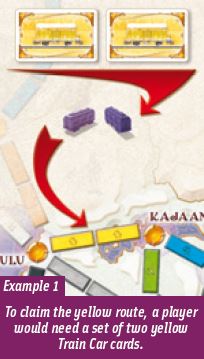
To claim a route, a player must play a set of cards equal to the number of spaces in the route.
A set of cards must be of the same color. Most routes require a specific type of set.
For example a Blue route must be claimed using blue-colored Train Car cards. Some routes - those that are Gray colored - can be claimed using a set of cards of any one color.
The Murmansk-Lieksa route is an exception. On this route, a player can use any four cards (including locomotives) as a substitute for a card of any color.
Example: A player could claim the route by playing 7 green cards and any 8 other cards.
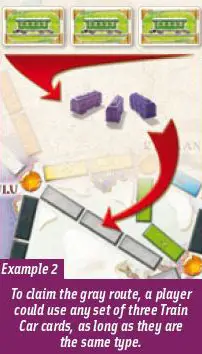
When a route is claimed, the player places one of his plastic trains in each of the spaces of the route. All the cards in the set used to claim the route are then placed in a discard pile next to the draw pile.
A player may claim any open route on the board. He is never required to connect to any of his previously played routes.
A player may only claim a maximum of one route, hence connect two adjacent cities, never more, on his turn.
Some cities are connected by Double-Routes. One player cannot claim both routes to the same cities.
Important note: In 2 player games, only one of the Double-Routes can be used. A player can claim either of the two routes between cities, but the other route is then closed to other players.
Ferries
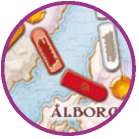
Ferries are special routes linking two adjacent cities across a body of water. They are easily identified by the Locomotive icon(s) featured on at least one of the spaces making the route.
To claim a Ferry Route, a player must play a Locomotive card for each locomotive symbol on the route, and the usual set of cards of the proper color for the remaining spaces of that Ferry Route.
In addition:
A player can play additional Locomotive cards as a substitute for a color card
Any three cards can be used as a substitute for a Locomotive card
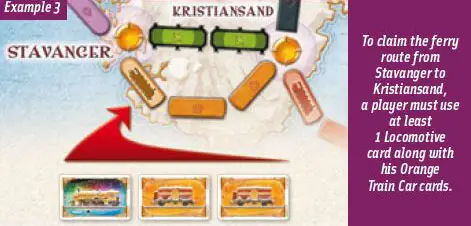
Tunnels
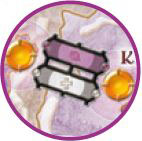
Tunnels are special routes that are easily identified by the special tunnel marks and outlines surrounding each of their spaces.
What makes a tunnel special is that a player is never quite certain just how long the route he is trying to claim will be!
When attempting to claim a Tunnel route, a player first lays down the number of cards required. Then the 3 top cards from the Train Car card draw pile are turned face-up.
For each card revealed whose color matches the color used to claim the Tunnel (including locomotives), an additional card of the same color (or a locomotive) must be played to successfully claim the Tunnel. See Examples 1 and 2.
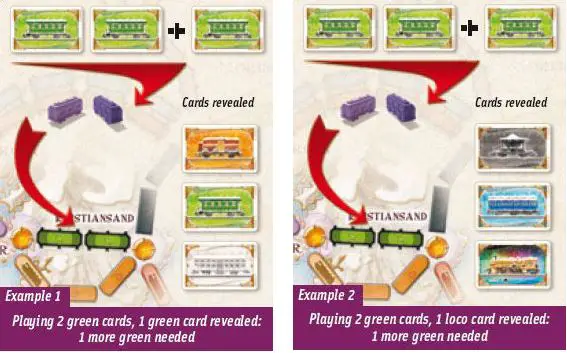
If the player does not have enough additional Train Car cards of matching color (or does not wish to play them), he may take all his cards back into his hand, and his turn ends. The three Train Car cards revealed for the Tunnel are discarded.
Be aware that with regard to Tunnels:
-
Locomotives are multi-colored wild cards. As such, any Locomotive card revealed, forces the player to add a Train Car card (of matching color) or a Locomotive from your hand.
-
If a player exclusively plays Locomotive cards to claim a tunnel route, only additional Locomotive cards drawn from the deck will be considered a match.
This means you will not have to worry about a colored card of the Tunnel's color triggering a match! If Locomotive cards appear in the 3 cards drawn for the Tunnel, triggering a match, it can only be fulfilled by playing additional Locomotive cards from your hand. See Example 3.
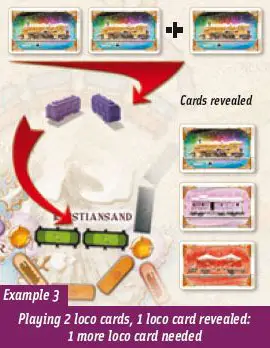
Route Scoring Table
When a player claims a route, he records the points he receives by moving his Scoring Marker on the Scoring Track. See Route Table below.
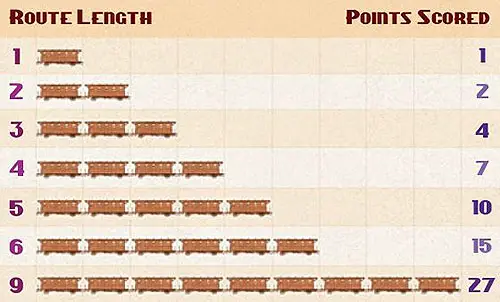
Drawing Destination Ticket Cards
A player can use his turn to draw more Destination Ticket cards. To do so, he draws 3 new cards from the top of the Destination Ticket deck. He must keep at least one of the cards, but may also keep two or all three if he chooses.
If there are less than 3 Destination Tickets left in the deck, the player only draws what cards are available. Any returned cards are removed
Each Destination Ticket includes the name of two cities on the map and a Point Value. If a player successfully completes a series of routes that connect the two cities, they will add the amount of points indicated on the Destination Ticket to their point totals at the end of the game.
If they do not successfully connect the two cities, they deduct the amount of points indicated.
Destination Tickets are kept secret from other players until the game's final scoring. A player may accumulate any number of Destination Ticket cards during the game.
End of the Game
When one player's stock of colored trains gets down to only two trains or less at the end of his turn, each player, including that player, gets one final turn. The game then ends and players calculate their final scores.
Calculating Scores
Players should have already accounted for the points earned as they completed different routes. To make sure no mistakes were made, you may want to re-count the points for each player's routes.
Players should then reveal all their Destination Tickets and add (or subtract) the value of their Destination Tickets still in hand, based on whether they successfully (or not) connected those cities together.
The player who has completed the most Destination Tickets receives the Globetrotter Bonus card and adds 10 points to his score. In the case of a tie, all tied players score the 10 point bonus.
The player with the most points wins the game.
If two or more players are tied for the most points, the player who has completed the most Destination Tickets wins. In the unlikely event that they are still tied, the player with the longest route wins.
Other Ticket to Ride Games
Continue Reading


